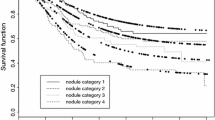Abstract
Due to significant progress in cancer treatments and management in survival studies involving time to relapse (or death), we often need survival models with cured fraction to account for the subjects enjoying prolonged survival. Our article presents a new proportional odds survival models with a cured fraction using a special hierarchical structure of the latent factors activating cure. This new model has same important differences with classical proportional odds survival models and existing cure-rate survival models. We demonstrate the implementation of Bayesian data analysis using our model with data from the SEER (Surveillance Epidemiology and End Results) database of the National Cancer Institute. Particularly aimed at survival data with cured fraction, we present a novel Bayes method for model comparisons and assessments, and demonstrate our new tool’s superior performance and advantages over competing tools.
Similar content being viewed by others
References
Banerjee S, Wall M, Carlin BP (2003) Frailty modeling for spatially correlated survival data, with application to infant mortality in Minnesota. Biostatistics 4: 123–142
Bennett S (1983) Analysis of survival data by the proportional odds model. Stat Med 2: 273–277
Berkson J, Gage RP (1952) Survival curve for cancer patients following treatment. J Am Stat Assoc 47: 501–515
Chen M-H, Ibrahim JG, Sinha D (1999) A new Bayesian model for survival data with a surviving fraction. J Am Stat Assoc 94: 909–919
Collett D (1994) Modelling survival data in medical research. Chapman and Hall, London
Cooner F, Banerjee S, Carlin BP, Sinha D (2007) Flexible cure rate modeling under latent activation schemes. J Am Stat Assoc 102: 560–572
Cox DR, Oakes D (1984) Analysis of survival data. Chapman and Hall, London
Ewell M, Ibrahim JG (1997) The large sample distribution of the weighted log-rank statistic under general local alternatives. Lifetime Data Anal 3: 5–12
Farewell VT (1982) The use of mixture models for the analysis of survival data with long term survivors. Biometrics 38: 1041–1046
Farewell VT (1986) Mixture models in survival analysis: are they worth the risk. Can J Stat 14: 257– 262
Gelfand AE, Ghosh SK (1998) Model choice: a minimum posterior predictive loss approach. Biometrika 85: 1–11
Gray RJ, Tsiatis AA (1989) A linear rank test for use when the main interest is in differences in cure rate. Biometrics 45: 899–904
Hanin LG, Zaider M, Yakovlev AY (2001) Distribution of the number of clonogens surviving fractionated radiotherapy: a long-standing problem revisited. Int J Radiat Biol 77: 205–213
Ibrahim JG, Chen M-H, Sinha D (2001a) Bayesian survival analysis. Springer-Verlag, New York
Ibrahim JG, Chen M-H, Sinha D (2001b) Criterion based methods for Bayesian model assessment. Stat Sin 11: 419–443
Li C, Taylor JMG (2002) A semi-parametric accelerted failure time cure model. Stat Med 21: 3235–3247
Maller RA, Zhou S (1996) Survival analysis with long-term survivors. Wiley, New York
Stangl DK, Greenhouse JB (1998) Assessing placebo response using Bayesian hierarchical survival models. Lifetime Data Anal 4: 5–28
Susarla V, Ryzin J (1976) Nonparametric Bayesian estimation of survival curves from incomplete observations. J Am Stat Assoc 61: 897–902
Sy JP, Taylor JMG (2000) Estimation in a proportional hazards cure model. Biometrics 56: 227–336
Tsodikov AD, Ibrahim JG, Yakovlev AY (2003) Estimating cure rates form survival data. J Am Stat Assoc 98: 1063–1078
Tucker SL, Taylor JMG (1996) Improved models of tumour cure. Int J Radiat Biol 70: 539–553
Yakovlev AY (1994) Letter to the editore. Stat Med 13: 983–986
Yakovlev AY, Tsodikov AD (1996) Stochastic models of tumor latency and their biostatistical applications. World Scientific, New Jersey
Yakovlev AY, Asselain B, Bardou VJ, Fourquet A, Hoang T, Rochefediere A, Tsodikov AD (1993) A simple stochastic model of tumor recurrence and its applications to data on pre-menopausal breast cancer. Biometrie et Analyse de Dormees Spatio-Temporelles 12: 66–82
Yin G, Zeng D, Ibrahim JG (2006) Semiparametric transformation models for survival data with a cure fraction. J Am Stat Assoc 101: 670–684
Author information
Authors and Affiliations
Corresponding author
Rights and permissions
About this article
Cite this article
Gu, Y., Sinha, D. & Banerjee, S. Analysis of cure rate survival data under proportional odds model. Lifetime Data Anal 17, 123–134 (2011). https://doi.org/10.1007/s10985-010-9171-z
Received:
Accepted:
Published:
Issue Date:
DOI: https://doi.org/10.1007/s10985-010-9171-z




